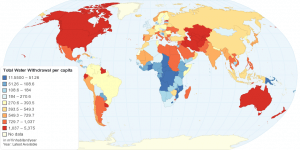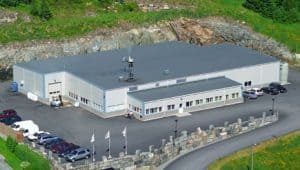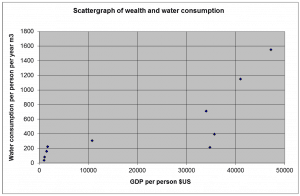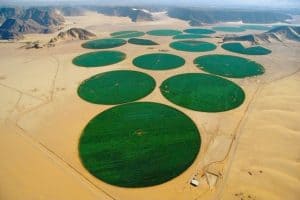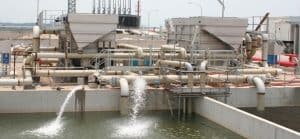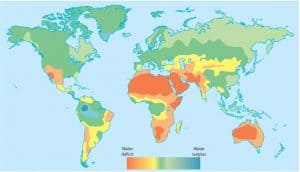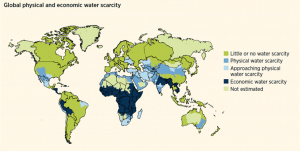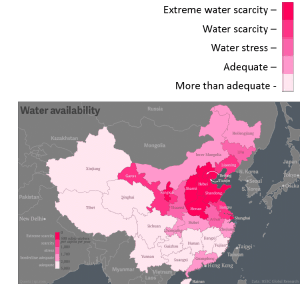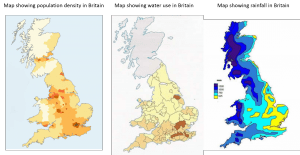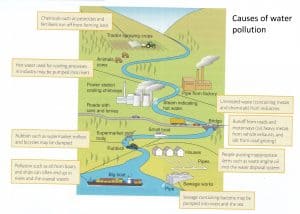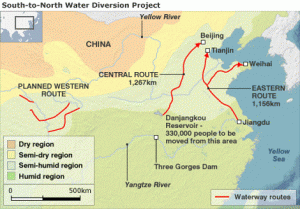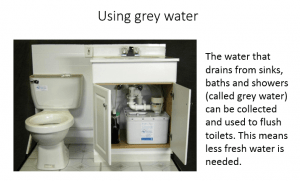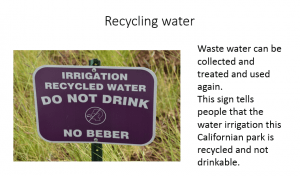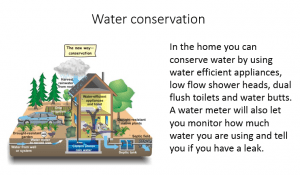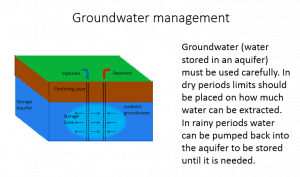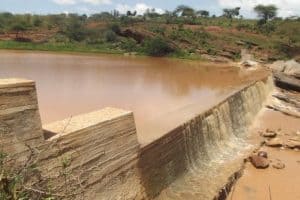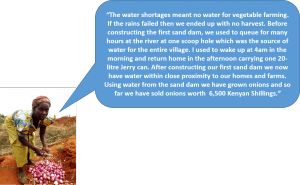In HICs like USA and Australia water conumption is high with over 1000 m3 used per person per year. In sub-Saharan Africa water consumption is low with under 100 m3 annually by each person.
There are three uses for water: domestic, industry and agriculture.
The proportion of water used in the home, in factories or on the farm varies around the world.
Why is water consumption increasing?
In 1950 the average person used 50 litres of water per day.
By 2000 the average person was using 150 litres per day.
This scattergraph shows a positive correlation between wealth and water use. It shows that wealthier countries consume more water.
One reason for increasing water consumption is the increasing size of 
the world’s population. More people mean more water is used.
The growing world population needs more food to eat. Crops need water to grow like these pivot irrigation fields in Libya. This uses lots of water.
As the population of many countries get wealthier they use more 
appliances such as dishwashers in the home. Domestic water
consumption is rising.
As the world gets richer it uses more electricity. Power stations use lots of water in cooling.
As the world gets richer it is buying more products made in factories. Industrial water use is increasing.
To produce 1kg of rice use 3000 litres of water. 1kg of beef needs 16000 litres of water. As the world gets richer people eat more meat so water consumption is increasing.
Water surplus and deficit
Water surplus – there is more water there than people need. There is a lot of rainfall and not much evaporation so there is enough water for the population.
Water deficit – there is less water there than people need. There is little rainfall and lots of evaporation so there is not enough water for the population.
Water supply
In parts of the world there is a physical water scarcity. In other parts there is an economic water scarcity. Water security or insecurity is affected by physical factors and economic factors.
Impacts of water insecurity
In Kenya there is water insecurity. This means many people drink from unsuitable sources. This increases the risk of water borne diseases. Collecting water also means women and girls have no time for paid work or an education.
In Mumbai, India, water pollution leads to water insecurity as lots of water is polluted. These dogs have be swimming in a river polluted with dye.
These dogs have be swimming in a river polluted with dye.
In China water insecurity means that there is not enough water for industry in north east China.
Cameroon, Chad, Niger and Nigeria surround the Lake Chad Basin, which is considered one of the worst conflict zones in Africa. There have been repeated conflicts among nationals of different countries over control of the remaining water in Lake Chad. The lake itself has shrunk by as much as 95% from 1963 but provides water to more than 68 million people. The impact of the drying lake is causing tensions among communities with Cameroon and Nigeria in conflict over water. Fishermen are also demanding that farmers stop diverting lake water to irrigate their land. The area contains 3 million refugees forced to flee from famine, drought and conflict.

Water in the UK
Water surplus and deficit in the UK and water transfers.
In the UK most rainfall falls on the mountains of Wales and Scotland, however, few people live here: there is a water surplus. Most people in the UK live in the south and east so here consumption is higher but there is little rainfall: there is a water deficit. This imbalance was been addressed by building dams, reservoirs and aqueducts to transfer water. In the Elan Valley in Wales reservoirs collect and store water. It is transfered to Birmingham using a 73 miles aqueduct.
Water pollution in the UK
Eutrophication is a form of water pollution. It occurs when nitrates and phosphates are washed into rivers and lakes. This causes alage and plants to grow and then die. Decomposers multiply and use up oxygen in the water. This leads to fishing and other aquatic life dying. To control eutrophication nitrates and phosphate levels have been reduced in washing powders, large fines imposed for pollution and buffer strips used alongside rivers where trees grow to prevent fertilizers being washed off farmland.
An example of a large-scale water transfer scheme
The China North South Water Transfer Scheme diverts water from the Yangtze in the south towards Beijing in the north. 44.8 billion m3 of water per year will be sent to the 200 million people who live in a region of water scarcity. The diverted water will help to create 600 000 new jobs and help irrigate crops on the North Chinese Plain. Without this new water, the local aquifers will run out in 30 years.
However, 1.27 million people have been relocated and 788 heritage sites will be lost as land is flooded for dams, reservoirs and canals. It has also cost £62 billion. The diverted water from the Yangtze is heavy polluted and lots of it is lost on its journey. Diverting water from the Yangtze may also create water shortages in the south. Climate change is also reducing rainfall across China affecting how much water will be available in the future.
Strategies to reduce water scarcity
One way to increase water supply is to use desalination.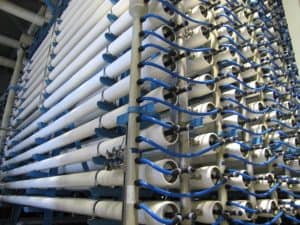
This is where salt is removed from sea water using filters.
In some countries where there is a water deficit, desalination has been used to improve supply. It has been used in HICs in arid countries such as USA, Australia and the Middle East.
However, desalination uses lots of energy. High pressure pumps are needed
to push sea water through the filters. This makes desalination expensive.
Other strategies may be more sustainable ways to tackle water scaricty. This ways aim to reduce water consumption or wastage.
An example of a local water supply scheme in a LIC
Kyeni Kya Thwake sand dam
Kyeni Kya Thwake sand dam was built in 2012 for a community of 500 people in central Kenya. Before it was built it was a 5km walk from the village to a nearby river to collect water. This could take 6-7 hours each day in the dry season. Construction cost £8000 which was paid for by a charity.
Now 20 million litres of water are available close to homes. Women spend more time growing vegetables such as onions and tomatoes to sell. This improves their income. Girls can now attend school regularly, instead of collecting water. This improves their education. The health and hygiene of families has also improved.
